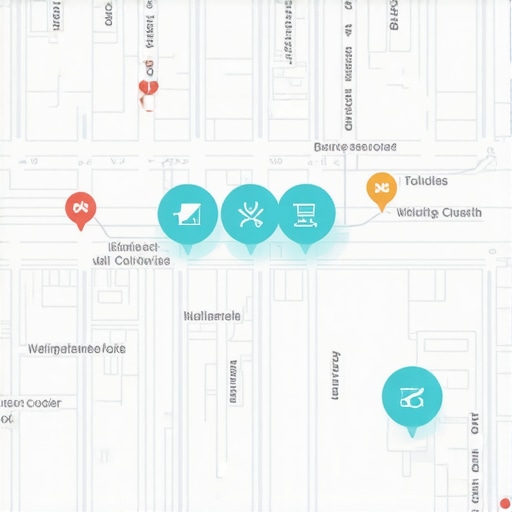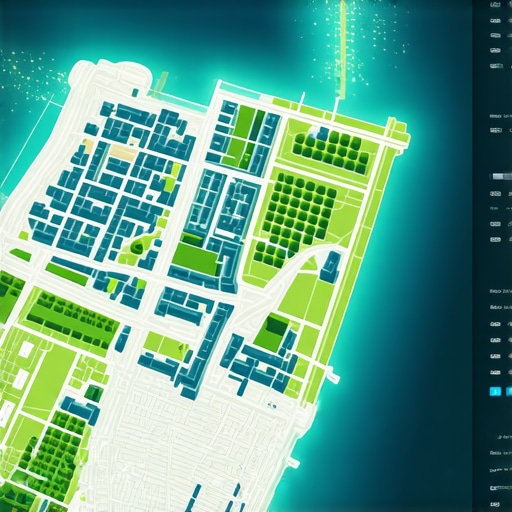Unlocking the Power of Advanced Maps SEO Strategies in 2024
As the digital landscape evolves, optimizing for local search visibility through effective Maps SEO techniques becomes paramount for businesses aiming to dominate Google rankings. In 2024, the challenge is not merely to optimize but to leverage sophisticated, data-driven strategies that align with Google’s evolving algorithms and user search intent. This article explores expert-level insights into how map optimization can significantly enhance your local SEO, ensuring your business remains competitive amidst increasing online clutter.
Why Traditional Local SEO Is No Longer Sufficient
Conventional approaches, such as basic Google My Business (GMB) optimization, are now insufficient in a landscape where AI and machine learning algorithms influence search results. Advanced Maps SEO involves integrating structured data markup, leveraging semantic keywords, and understanding user behavior patterns. These tactics ensure your local business appears prominently in geo-targeted searches, especially in competitive markets where subtle ranking signals can make a difference.
Harnessing Geo-Semantic Optimization for Unparalleled Visibility
Geo-semantic keywords—terms that combine geographic and contextual relevance—are crucial for ranking higher in local search maps. Incorporating these into your NAP (Name, Address, Phone Number), website content, and Google My Business profile aligns your digital presence with user intent. For instance, instead of generic keywords like “plumber,” use geo-specific terms like “emergency plumber in Downtown Manhattan,” which capture localized search intent with precision.
Implementing Schema Markup to Enhance Map Listings
Structured data markup, particularly LocalBusiness schema, is a technical cornerstone for Maps SEO in 2024. Proper implementation helps search engines understand your business context, facilitating rich snippets and enhanced map listings. Consider employing Google’s structured data guidelines to ensure your schema markup aligns with latest standards, thus improving your chances of appearing in the coveted local pack.
What Are the Top Challenges in Maps SEO Optimization Today?
Experts often debate the impact of AI-driven search personalization versus traditional ranking signals. The grey area involves understanding how Google’s local algorithms weigh user engagement metrics like reviews, click-through rates, and behavioral signals. Navigating this complexity requires continuous testing, data analysis, and adaptation. How do you prioritize these signals in your local SEO strategy to maximize visibility?
Call to Action: Elevate Your Maps SEO Tactics Today
To stay ahead in 2024, explore our comprehensive guide on top Maps SEO techniques. Contribute your insights or inquire about bespoke strategies tailored to your niche. The competitive edge lies in adopting a holistic, data-centric approach that continually refines your local search presence.
For further authoritative insights, refer to Google’s official structured data documentation.
Leveraging AI and Machine Learning: The Next Frontier in Maps SEO
As search engines become increasingly sophisticated, integrating AI and machine learning into your Maps SEO strategy is no longer optional—it’s essential. These technologies analyze user behavior patterns, preferences, and even real-time data to deliver hyper-relevant local search results. For example, leveraging AI-driven tools can help identify trending geo-specific keywords and optimize your content accordingly, ensuring your business stays ahead of the competition. Exploring how these advancements influence local rankings can be a game-changer; for insights, consider consulting authoritative sources like Moz’s guide on AI and SEO.
What Role Do User Intent and Behavioral Signals Play in Maps Optimization?
Understanding user intent has always been pivotal, but in 2024, it takes on new dimensions. Search engines increasingly prioritize behavioral signals such as click-through rates, dwell time, and review sentiment. Integrating these metrics into your local SEO analysis can help refine your strategy—enhancing your visibility in the coveted local pack. For instance, optimizing your Google My Business profile with compelling images, accurate NAP details, and engaging responses to reviews can positively influence these signals, boosting your local rankings. Want to deepen your understanding? Visit our expert strategies for Google Maps SEO.
Consider the impact of structured data markup in your Google My Business listings. Proper implementation of LocalBusiness schema helps search engines interpret your business details more accurately, leading to enhanced visibility and rich snippets. This technical layer complements your content strategy, providing a comprehensive approach to Maps SEO. For detailed technical guidance, refer to Google’s official schema markup documentation.
Are We Truly Maximizing Local Search Potential or Still Relying on Outdated Tactics?
Many businesses continue to focus on basic optimization without embracing the full spectrum of advanced techniques. To truly dominate local search in 2024, it’s crucial to integrate geo-semantic keywords, leverage structured data, and analyze behavioral signals comprehensively. Doing so not only improves your rankings but also builds a resilient local presence that adapts to evolving algorithms. For a comprehensive roadmap, explore our proven strategies to boost Google Maps visibility.
If you found these insights valuable, share your thoughts or experiences in the comments. Want more expert-level tactics? Check out our full guide on Maps SEO and Google Visibility in 2024.
Harnessing Local Data Clusters to Elevate Your Maps SEO Performance
In the ever-evolving domain of local search, the deployment of geo-clustered data strategies can significantly amplify your visibility. By leveraging advanced clustering algorithms, such as DBSCAN or HDBSCAN, you can identify and target micro-geographies within your broader service area, tailoring content and optimization efforts to these high-impact zones. These clusters often reveal underserved niches or emerging neighborhoods, enabling proactive engagement before competitors recognize their potential.
Implementing these techniques requires integrating spatial analytics tools like ArcGIS or QGIS with your existing data pipelines. The benefit is a nuanced understanding of localized demand patterns, which can inform hyper-targeted keyword strategies and localized content creation, thus aligning your digital presence more precisely with user intent.
The Role of Voice Search and Conversational AI in Map Optimization
As voice search continues its ascendancy, understanding and optimizing for conversational queries become critical. Unlike traditional keyword searches, voice queries tend to be longer, more natural, and often contextually rich. For example, a user might say, “Find the best gluten-free bakery near me that is open now.” To optimize, businesses must incorporate natural language snippets into their Google My Business descriptions and website content, focusing on question-based keywords and local intent cues.
Furthermore, integrating AI-driven chatbots that utilize NLP (Natural Language Processing) can enhance user engagement on your site, gather behavioral data, and improve your understanding of voice search patterns. These insights can then be translated into refined local SEO strategies, ensuring your business remains voice-search-friendly and accessible.
How Do Hyperlocal Content Strategies Influence Map Rankings in Competitive Markets?
Hyperlocal content—targeted, community-specific narratives—serves as a powerful tool to differentiate your business in saturated markets. By creating blog posts, event updates, and customer success stories centered around specific neighborhoods, you signal to search engines a deep local relevance. Incorporating geo-semantic keywords within this content further enhances your chances of appearing in map packs for hyperlocal queries.
Advanced content strategies also involve integrating user-generated content, such as reviews and photos, which bolster your local authority. Additionally, employing schema markup to highlight these hyperlocal elements ensures that search engines can contextualize your content effectively, translating into improved map visibility and richer snippets.
Advanced Schema Markup Techniques for Dynamic Map Rich Snippets
While basic LocalBusiness schema remains foundational, innovative schema implementations can unlock dynamic map features. For instance, employing ‘Event’, ‘Service’, or ‘Offer’ schemas within local listings allows your map entries to display real-time information—upcoming events, special promotions, or new service offerings—directly in SERP snippets. This dynamic approach not only boosts click-through rates but also signals freshness and relevance to algorithms.
Tools like Google’s Structured Data Markup Helper and testing tools like the Rich Results Test are invaluable for ensuring correct implementation. Regular audits and updates to schema markup are necessary to adapt to Google’s evolving standards and to capitalize on emerging map features.
Addressing the Nuances of Local Algorithm Personalization and User Behavior Signals
Google’s local algorithms increasingly prioritize personalized search results, influenced by user behavior signals such as previous interactions, location history, and review sentiment. To effectively influence these signals, businesses must adopt a multi-layered approach: actively solicit and manage reviews, optimize for engagement metrics, and personalize content based on localized user data.
For example, implementing geo-targeted promotions and interactive maps within your website can encourage dwell time and engagement, positively influencing local rankings. Additionally, monitoring behavioral analytics through tools like Google Analytics and Search Console offers insights into user journeys, enabling continuous refinement of your local SEO tactics.
Explore More with Our Deep-Dive Resources
To stay ahead in 2024, it’s crucial to integrate these advanced strategies into your Maps SEO toolbox. Dive deeper into our comprehensive resources, including case studies and technical guides, by visiting our expert portal. Share your experiences or ask questions in the comments—collaborative learning accelerates success in competitive local markets.
Unlocking Hyperlocal Optimization Techniques for Niche Markets
As competition intensifies, hyperlocal SEO tactics are becoming essential for businesses targeting specific neighborhoods or micro-communities. Deploying hyperlocal content—such as neighborhood stories, local event coverage, and community collaborations—can significantly enhance your relevance in map packs. Integrating geo-semantic keywords tailored to these micro-geographies ensures your business resonates with localized search intent, elevating your visibility among highly targeted audiences.
Harnessing the Power of Machine Learning for Predictive Map Ranking
Emerging machine learning models enable predictive analytics in local search rankings by analyzing patterns in user behavior, seasonal trends, and competitive landscapes. Utilizing AI-driven tools like TensorFlow or custom ML models can forecast shifts in local demand and adjust your SEO tactics proactively. This advanced approach allows for dynamic content updates, strategic NAP adjustments, and optimized service offerings aligned with forecasted search trends, thus maintaining a competitive edge.
What Are the Cutting-Edge Schema Markup Innovations for Rich Map Snippets?
Recent developments in schema markup involve leveraging Schema.org extensions such as Product, Offer, and Event to generate dynamic, context-rich snippets directly within map listings. These schemas facilitate real-time promotion of special offers, upcoming events, or product launches, making your map listing more engaging and informative. Implementing these schemas requires meticulous adherence to Google’s structured data guidelines, which can be explored in detail at Google’s official schema documentation.

Integrating Sentiment Analysis to Enhance Review Optimization
Advanced sentiment analysis tools, such as MonkeyLearn or Lexalytics, enable businesses to systematically interpret review sentiment and identify areas needing improvement. By analyzing review data at scale, you can craft targeted responses, enhance customer engagement, and proactively address negative feedback. This strategic approach not only improves review scores but also influences behavioral signals that Google considers in local ranking algorithms, thus reinforcing your map visibility.
Could Voice Search Optimization Unlock Untapped Local Opportunities?
Optimizing for voice search involves more than including conversational keywords; it requires a comprehensive understanding of voice query intent and the deployment of structured data to facilitate voice-friendly snippets. Implementing FAQ schemas, natural language content, and location-specific conversational phrases enables your business to appear prominently in voice-activated local searches. As voice search adoption accelerates, mastering this facet of SEO can unlock significant new streams of local traffic and conversions.
How to Leverage Spatial Analytics for Precision in Map Visibility?
Spatial analytics platforms such as ArcGIS and QGIS provide granular insights into geographic demand patterns and customer distribution. By integrating these tools with your CRM and marketing data, you can identify underserved zones, optimize service area boundaries, and tailor marketing campaigns to micro-geographies. This precision targeting enhances your local relevance and ensures your map listings appear in the most pertinent search results, thus boosting overall visibility.
Explore Further: Elevate Your Maps SEO Strategy Today
For an in-depth exploration of these advanced techniques, visit our comprehensive guide. Engage with seasoned SEO professionals or share your success stories in the comments. Elevate your local search game with innovative, data-driven tactics designed for the competitive landscape of 2024 and beyond.
Expert Insights & Advanced Considerations
1. Leverage Geo-Semantic Clustering for Hyper-Targeted Optimization
Utilize spatial analytics tools like ArcGIS or QGIS to identify micro-geographies within your service area. Implement clustering algorithms such as DBSCAN to uncover underserved neighborhoods, enabling hyper-targeted content and keyword strategies that improve local relevance and map rankings.
2. Integrate Dynamic Schema Markup for Real-Time Map Enhancements
Beyond basic LocalBusiness schema, deploy real-time schemas like Event, Offer, or Product to showcase ongoing promotions, upcoming events, or new services directly in map snippets. This dynamic data boosts engagement and signals freshness to Google’s algorithms.
3. Optimize for Voice Search with Conversational Content and NLP
Develop FAQ-rich content with natural language snippets and implement structured data to facilitate voice-activated local searches. Enhancing your voice search optimization broadens your reach in an increasingly voice-driven search landscape.
4. Harness Machine Learning for Predictive Local Demand Analysis
Employ AI tools such as TensorFlow or custom ML models to forecast demand trends and adjust your local SEO tactics proactively. This strategic foresight ensures your business remains ahead of competitors in local search visibility.
5. Use Sentiment Analysis to Refine Review Management
Deploy sentiment analysis tools like MonkeyLearn or Lexalytics to interpret review sentiments systematically. Addressing negative feedback and amplifying positive reviews enhances behavioral signals that influence local rankings.
Curated Expert Resources
- Google’s Structured Data Guidelines: Essential for implementing schema markup aligned with current standards, improving rich snippets and map visibility.
- Moz’s Guide on AI and SEO: Offers comprehensive insights into leveraging AI technologies for local search optimization.
- Google Developers Structured Data Documentation: A technical resource for advanced schema markup strategies and troubleshooting.
- ArcGIS and QGIS Spatial Analytics Platforms: Crucial tools for micro-geography analysis and hyperlocal targeting.
- TensorFlow and Custom ML Models: For predictive analytics and demand forecasting in local SEO.
Final Expert Perspective
Mastering Maps SEO in 2024 demands a sophisticated blend of geo-semantic clustering, dynamic schema markup, voice search optimization, and predictive analytics. These advanced strategies, supported by authoritative resources, empower businesses to dominate local search landscapes with precision and agility. To deepen your expertise and stay at the forefront, explore our comprehensive guide on Maps SEO and Google Visibility in 2024. Engage with industry peers, share your insights, and continuously refine your approach to unlock unprecedented local search success.





Sophia Williams
I found this article incredibly insightful, especially the emphasis on geo-semantic keywords and structured schema markup. In my experience managing local SEO for a small chain of cafes, integrating detailed schema markup and hyperlocal content made a noticeable difference in our map pack visibility. I’m curious, have others had success with AI-driven tools for identifying emerging geo-trends? It seems like leveraging machine learning for predictive analytics could be a game-changer, but I’m still exploring the most effective ways to incorporate this into daily strategies. Also, with the rise of voice search, I wonder how businesses can best optimize their content for natural language queries without overstuffing keywords? Would love to hear how fellow marketers are balancing these advanced tactics with practical implementation to stay ahead in competitive markets.
Benjamin Carter
This post really highlights how crucial it is to move beyond traditional local SEO tactics as we approach 2024. I’ve been experimenting with AI tools like PredictiveGeoAnalytics to identify micro-geographies that show emerging demand, and the results have been promising. It’s fascinating how combining spatial analytics with advanced schema markup can give your business a real edge in local search rankings. One challenge I’ve faced is ensuring that these data-driven strategies don’t become too complex for smaller teams to manage consistently. I’m curious—what are some effective ways to streamline these processes without sacrificing the depth of analysis needed for hyperlocal targeting? Additionally, with voice search becoming more prevalent, I’d love to hear how others are optimizing conversational content to match natural language queries while maintaining relevance. Has anyone found successful approaches for integrating voice optimization smoothly into their overall Maps SEO strategy? Would be great to exchange insights and best practices with others navigating these dynamic trends.